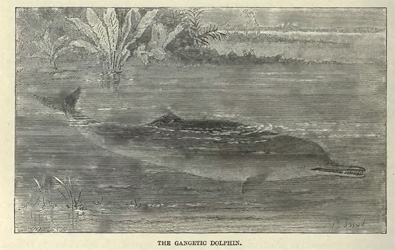Asian river dolphins are among the most threatened large vertebrates, because the regions where they occur have high human population densities, resource overexploitation and environmental degradation, with escalating pressures on local biodiversity and diminishing ecosystem services.
Tragically we have already been witness to the extinction of the Yangtze River dolphin or Baiji. Efforts to better understand the key factors threatening the Ganges River dolphin with extinction have already begun in the Assam region of India, however funding has recently been secured to extend research down into Bangladesh throughout the Ganges-Brahmaputra-Meghna and Karnaphuli river systems. Funding is for a three year PhD project based here at ZSL but in collaboration with Julia Jones of University of Bangor, and Dr. Simon Northridge of the Sea Mammal Research Unit in St. Andrews. The project shall build upon some of the current research being done by the Wildlife Conservation Society’s (WCS) Bangladesh Cetacean Diversity Project which has already started documenting habitat preferences, abundance hot spots, and resource use in this species.

This species is considered to be particularly threatened by overfishing (incidental by-catch, direct exploitation, resource depletion), and high industrial and agricultural pollutant loads may also have a severe impact on dolphin immunocompetence and fertility. However, although these threat processes are known to constitute major causes of mortality in cetacean populations worldwide, almost no information is available on the interactions of Ganges River dolphins with fisheries or fish stocks, and similarly little is known about either observed levels or predicted health effects of persistent organic pollutant loads in the species. In the absence of such data, it is effectively impossible to assess the conservation status of the species across its range, or to develop appropriate sustainable recovery strategies.
The purpose of this project is to identify patterns and drivers of river dolphin mortality, and the relationship between regional river dolphin abundance and the status of commercially significant freshwater fish species (e.g. hilsa shad). Data on the timing, cause and distribution of river dolphin mortality events (including both incidences of by-catch and other events) will be gathered during an extensive interview survey of knowledgeable informants from riverside fishing communities across Bangladesh. During the survey additional data shall be collected on fishing gear type and use in different parts of the river system during both high- and low-water seasons, data on fish catch size and composition for target fisheries representing important resources for local communities. Further data on fishing gear use, and landings shall be obtained from the Bangladesh Fisheries Research Institute. In order to look at pollutant loads in the dolphin, tissue samples shall be obtained from carcasses and returned to the UK for analysis.
The findings of this study shall both provide an important insight into the major factors contributing to the decline of this highly threatened species and therefore identify appropriate conservation recommendations, but shall further develop the effectiveness of monitoring techniques employed when studying cryptic, aquatic species such as this.
The project will officially start at the beginning of October, but work is already underway to plan for a field season in early 2011. A one month trip is planned for November/ December 2010 in which Dr. Sam Turvey (project principal supervisor) and Nadia Richman (PhD student) will go to Bangladesh to meet with the WCS team and discuss the logistics of fieldwork across the country.


